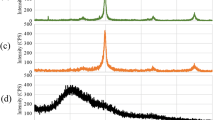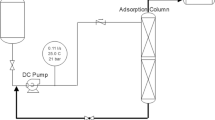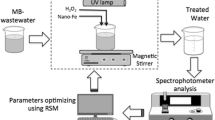Abstract
This research is focused on the adsorption of Acid Black 26 dye from aqueous solutions using zeolite as an adsorbent. The experiments were designed by response surface methodology. Quadratic model was used to predict the variables. Analysis of variance was used for investigation of variables and interaction between them. The highest removal percent (87.98%) was attained, and the optimum parameters are achieved: zeolite amount (0.55 g), dye concentration (25.78 mg L−1), pH = 4, and time (59.99 min). F value (329.44), P value (< 0.0001), the adequate precision (66.04), non-significant lack of fit, and R2 = 0.9970 demonstrate a good correlation between experimental and predicted data.


Similar content being viewed by others
References
Armaǧan B, Özdemir O, Turan M, Celik MS (2003) The removal of reactive azo dyes by natural and modified zeolites. J Chem Technol Biotechnol 78(7):725–732
Bezerra MA, Santelli RE, Oliveira EP, Villar LS, Escaleira LA (2008) Response surface methodology (RSM) as a tool for optimization in analytical chemistry. Talanta 76(5):965–977
Bulut Y, Aydın H (2006) A kinetics and thermodynamics study of methylene blue adsorption on wheat shells. Desalination 194(1–3):259–267
Cardoso AM, Paprocki A, Ferret LS, Azevedo CM, Pires M (2015) Synthesis of zeolite Na-P1 under mild conditions using Brazilian coal fly ash and its application in wastewater treatment. Fuel 139:59–67
Cazetta AL, Vargas AM, Nogami EM, Kunita MH, Guilherme MR, Martins AC, Silva TL, Moraes JC, Almeida VC (2011) NaOH-activated carbon of high surface area produced from coconut shell: kinetics and equilibrium studies from the methylene blue adsorption. Chem Eng J 174(1):117–125
Eremia SA, Chevalier-Lucia D, Radu GL, Marty JL (2008) Optimization of hydroxyl radical formation using TiO 2 as photocatalyst by response surface methodology. Talanta 77(2):858–862
Greluk M, Hubicki Z (2011) Efficient removal of Acid Orange 7 dye from water using the strongly basic anion exchange resin Amberlite IRA-958. Desalination 278(1):219–226
Hui KS, Chao CYH, Kot SC (2005) Removal of mixed heavy metal ions in wastewater by zeolite 4A and residual products from recycled coal fly ash. J Hazard Mater 127(1):89–101
Ioannou Z, Karasavvidis C, Dimirkou A, Antoniadis V (2013) Adsorption of methylene blue and methyl red dyes from aqueous solutions onto modified zeolites. Water Sci Technol 67(5):1129–1136
Kobya M, Gengec E, Sensoy MT, Demirbas E (2014) Treatment of textile dyeing wastewater by electrocoagulation using Fe and Al electrodes: optimisation of operating parameters using central composite design. Color Technol 130(3):226–235
Kumar SNA, Ritesh SK, Sharmila G, Muthukumaran C (2013) Extraction optimization and characterization of water soluble red purple pigment from floral bracts of Bougainvillea glabra. Arab J Chem
Musyoka NM, Petrik LF, Balfour G, Gitari WM, Hums E (2011) Synthesis of hydroxy sodalite from coal fly ash using waste industrial brine solution. J Environ Sci Health A 46(14):1699–1707
Nagul EA, Fontàs C, McKelvie ID, Cattrall RW, Kolev SD (2013) The use of a polymer inclusion membrane for separation and preconcentration of orthophosphate in flow analysis. Anal Chim Acta 803:82–90
Ngah WW, Hanafiah MAKM (2008) Adsorption of copper on rubber (Hevea brasiliensis) leaf powder: kinetic, equilibrium and thermodynamic studies. Biochem Eng J 39(3):521–530
Nidheesh PV, Gandhimathi R, Ramesh ST (2013) Degradation of dyes from aqueous solution by Fenton processes: a review. Environ Sci Pollut Res 20(4):2099–2132
Panda KK, Mathews AP (2014) Ozone oxidation kinetics of Reactive Blue 19 anthraquinone dye in a tubular in situ ozone generator and reactor: modeling and sensitivity analyses. Chem Eng J 255:553–567
Patel Y, Gupte A (2015) Biological treatment of textile dyes by agar-agar immobilized consortium in a packed bed reactor. Water Environ Res 87(3):242–251
Shojaei S, Shojaei S (2018) Optimization of process variables by the application of response surface methodology for dye removal using nanoscale zero-valent iron. International Journal of Environmental Science and Technology 1-0
Shojaei S, Shojaei S, Sasani M (2017) The efficiency of eliminating Direct Red 81 by Zero-valent Iron nanoparticles from aqueous solutions using response surface Model (RSM). Modeling Earth Systems and Environment 3(1):27
Shojaei S, Shojaei S, Sasani M (2017) The efficiency of eliminating Direct Red 81 by Zero-valent Iron nanoparticles from aqueous solutions using response surface model (RSM). Model Earth Syst Environ 3(1):27
Ugal JR, Hassan KH, Ali IH (2010) Preparation of type 4A zeolite from Iraqi kaolin: characterization and properties measurements. J Assoc Arab Univ Basic Appl Sci 9(1):2–5
Wdowin M, Franus M, Panek R, Badura L, Franus W (2014) The conversion technology of fly ash into zeolites. Clean Techn Environ Policy 16(6):1217–1223
Wu XW, Ma HW, Yang J, Wang FJ, Li ZH (2012) Adsorption of Pb (II) from aqueous solution by a poly-elemental mesoporous adsorbent. Appl Surf Sci 258(14):5516–5521
Yetilmezsoy K, Saral A (2007) Stochastic modeling approaches based on neural network and linear–nonlinear regression techniques for the determination of single droplet collection efficiency of countercurrent spray towers. Environ Model Assess 12(1):13–26
Author information
Authors and Affiliations
Corresponding author
Additional information
Publisher’s Note
Springer Nature remains neutral with regard to jurisdictional claims in published maps and institutional affiliations.
Rights and permissions
About this article
Cite this article
Shojaei, S., Shojaei, S. & Pirkamali, M. Application of Box–Behnken Design Approach for Removal of Acid Black 26 from Aqueous Solution Using Zeolite: Modeling, Optimization, and Study of Interactive Variables. Water Conserv Sci Eng 4, 13–19 (2019). https://doi.org/10.1007/s41101-019-00064-7
Received:
Revised:
Accepted:
Published:
Issue Date:
DOI: https://doi.org/10.1007/s41101-019-00064-7




